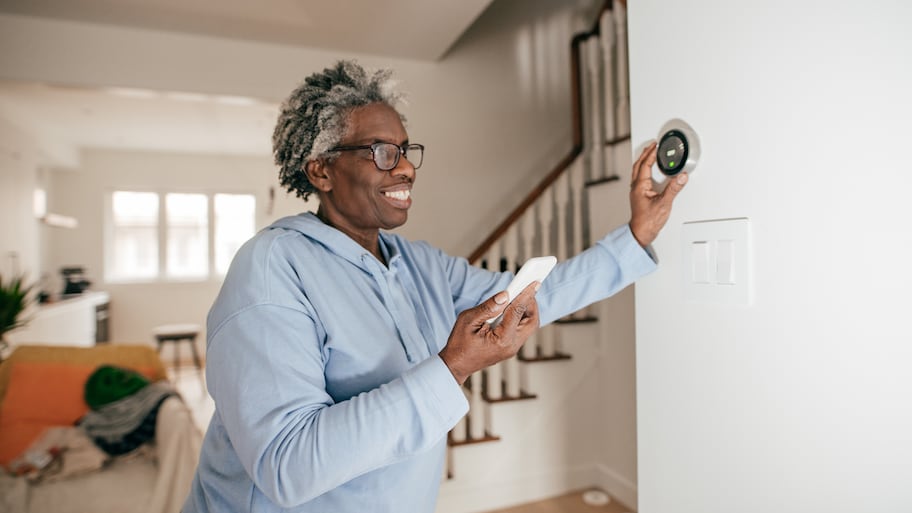For the sake of your appliances, favorite ficus, and energy bills, don't shut off that thermostat
There’s nothing quite like getting out of town for a much-deserved summer hiatus or a long-awaited winter getaway. But before you bolt out the door and onto the nearest sandy beach or sunny mountain top, you need to get your house in order—literally. And that means figuring out how you want to adjust your AC while you’re away.
The goal is to find that sweet spot between saving money on your heat bill and ensuring you don’t return home to a sauna or a meat locker. We’ll show you how to figure out the ideal settings for your home AC when you’re heading out of time. Hint: it all depends on when you’re leaving and how long you’ll be gone!
Why You Shouldn’t Turn Off Your AC
If you’re getting ready to hit the road, you might be tempted to shut off your AC completely. Why spend money to heat or cool an empty house, right? Well, it’s not quite that simple.
Excessive heat and cold aren’t good for your home, especially over extended periods of time. For instance, high heat and humidity can damage your sheetrock, meaning you could end up spending more to repair your walls than you saved on your energy bills.
But that’s not all—if you leave for summer vacation and shut off the AC, major appliances like your refrigerator and freezer are going to have to work that much harder to keep your food safe and cold. And, again, that’s going to jack up your energy costs as much, if not more, than you would save by turning off your AC.
The Sweet Spot: +/-5 Degrees
Have we convinced you yet? Whether you’re heading out for a much-needed weekend staycation or an extended getaway abroad, it’s a good idea to make sure your home remains comfy-cozy while you’re gone.
But that doesn’t mean you need to heat and cool your house just as you would if you were home. In fact, if you have an electric HVAC, you can generally aim for +/-5 degrees from your usual settings. If you have gas, then you can generally go another 1 or 2 degrees more.
That means that if you usually set your electric thermostat to 72 degrees, you can safely adjust to 77 for the summer months or 67 for the winter. That way, you’ll get the greatest energy efficiency without risking damage to your appliances, your sheetrock, or your favorite houseplants.
Maximizing Energy Efficiency
In addition to adjusting your temperature settings, there are also a number of quick and easy steps you can take to maximize energy efficiency and protect your house from punishing temperatures while you’re away.
Using curtains and window shades isn’t just great for keeping prying eyes away from your home, but it also helps keep sunlight and hot air out in summer and warm air in during the winter.
It’s also a good idea to do a top-to-bottom sweep of the house, checking doors, windows, basements, and attics for drafts and air leaks. Taking the time to seal those holes helps you save on your heating and cooling bills—not just when you’re on vacation, but all year long!
Consider a Smart Thermostat
Another great way to manage your heating and cooling costs while maintaining the healthiest climate for your home is to install a smart or programmable thermostat. Smart thermostats cost around $175 on average, while the cost to hire a local professional for thermostat installation is generally about $100 per hour, depending on where you live.
But for the cost and effort of installing a smart thermostat, you get the perk of being able to control your home’s temperature wherever you may be, all with the touch of your smartphone. So not only can you adjust your temperature settings based on the day’s weather conditions even when you’re not at home, but you can also gradually adjust to your family’s preferred temperature settings. You’ll always come home to the perfect Goldilocks house: not too hot, not too cold. And no more putting the HVAC on blast to do it!
The Takeaway
It might be tempting to shut off the HVAC when you’re heading out of town on your next vacation, but for the sake of your appliances, your walls, your energy bills, and your beloved houseplants, don’t do it! Instead, set your temperature about 5 degrees higher than your normal setting during summer and about 5 degrees lower during winter. That way, you’ll get maximum energy efficiency without hurting your home—or your hibiscus!




